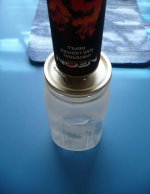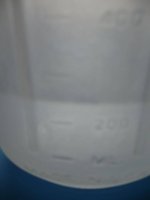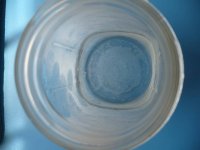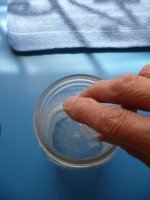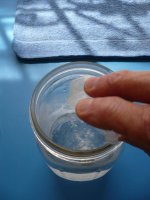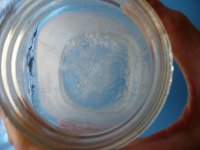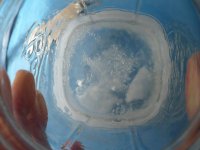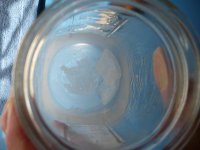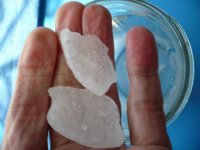I thought I had no water in my tank after purging atmosphere and then leaving it upside down in a fridge for 36 hours and the tank was down to 30F.
Then i was super low in the tank and a friend had borrowed my scale and I needed to keep moving so I said "fuck it" took the tank to a safe location turned it upside down and just dump the couple pounds that were left, I mean it was extremely.low I couldn't even flood a tube let alone get a wash.
I came back to discover A SERIOUS AMOUNT of frozen water all on the ground and on the weeds. I said to myself "there's no way that's water I'm using 2-600 gram pure molecular sieve 48 cubic inch filter driers!" So i sat there and watched it all melt, yep it was water for sure!
Hope this story helps
I was doing it every time it got low before I filled it up. It's a 100# tank so it big and heavy. I don't think 30F was enough to seperate the water but I've heard people leaving it overnight at ambient to bleed out the water. That was as low as the fridge thermostat would go. I think maybe you have to reach a certain saturation point.
One of the few good things that came from my battle with parker is that they told me the drier filters only will take out about half of the moisture in the system on every pass depending on saturation. Our setups are a bit different than a large AC setup. I think a longer drier filter would be great. I kinda wanted to go a 3x12 route as I mentioned before.
The actual properties of butane saturated with water has been nagging me, I've been thinking through a discovery test, adding a measured amount of water to my test bag and finding if it sublimes off or remains in the bag after the butane boils off. A saturation test at the boiling point of butane would also be simple, I suppose I'll just keep adding water until...???
If this info is all well known and understood I'm not seeing it being posted up. Theory is one thing, but seeing a phenomena for yourself in your own situation drives the point home.

Please read this one:
I just did the simple experiment mentioned above, I added about five grams of water to about 125g of cold openly contained butane, and it instantly formed a couple of large, solid, floating 'icebergs.'
I wasn't prepared for this, and therefore my camera was inaccessible, I'll do it again with pictures... big, three dimensional 'icebergs,' they contained large frothy bubbles from the initial action. They remained solid until the butane was gone, I never let the heated dish the test bag was sitting in get over 60F.
All the water seems to have been left behind going by the numbers.
If all the water drops out of butane and freezes if you lower the temperature, it would seem to me the way to remove all of the water in your tank/solvent would be to freeze the tank below 32F, and drain off the liquid solvent leaving the rock hard chunks of ice behind...
or most crudely, place your butane in an open container with the temperature down below 32F, and scoop out the ice with a strainer...

So, what about the azeotrope factor? I don't know, but Sunfire's observation seems to point in the direction of if there's azeotrope action going on it's probably minimal.
I've got a couple of pages of numbers, I measured and weighed everything... nothing much to note, though I did finally discover how much of a can of butane is blown by when squirting it into a quart Mason jar, more than I thought, over an ounce (159.9g actual net in the can, 126.5g in the jar, 32.8g lost.)
My next test I'll add the water while the butane is still in the jar to confirm the buoyancy of the 'icebergs' in a deeper pool of solvent, and take pics!!!
This was interesting!

So, GW, do you and WW get ice or whatever in your moisture trap, how does it ever get a chance if it's forming an ice build up to drain? I assume you'd do whatever you could to remove the last of the butane from the trap without heating it past freezing, and then melt and drain the ice/water?? If you've already explained this, or it's just supposed to be obvious as xxxx, pardon me.

One more thing, if there's a specific temperature you're aware of when the moisture drops out of the solvent, I don't think I recall the post.
Last edited:

